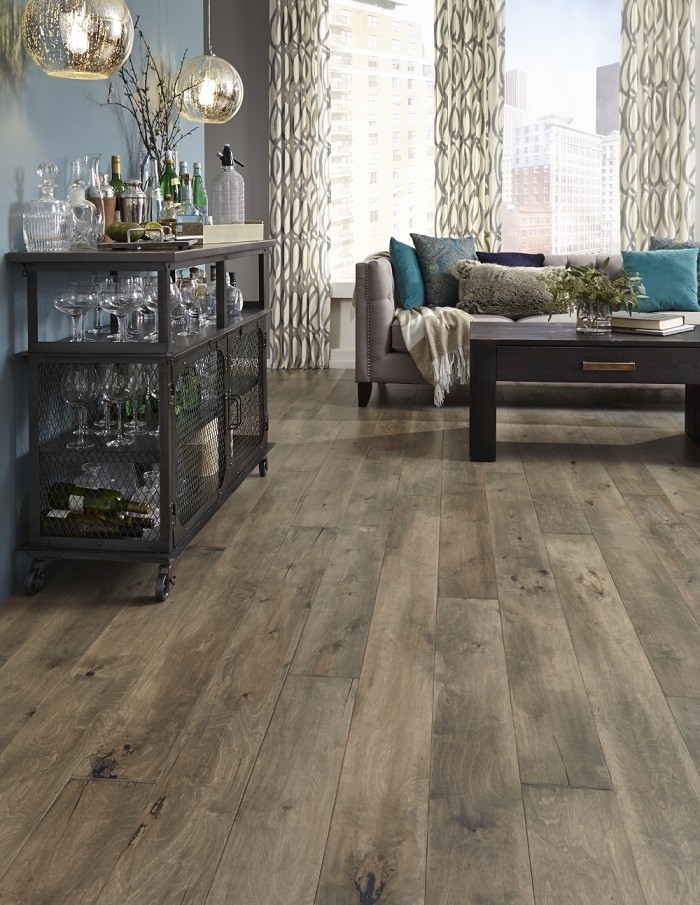Protect Your Hardwood Floors from Winter Weather Hazards

Winter can be a particularly unkind time of year to your floors. Especially for hardwood.
Don’t let the winter weather get the better of your beautiful floors! Watch out for these common winter weather flooring hazards and consider some additional steps for protection.
Salt
The Problem
Salt keeps the streets safe to drive on and the sidewalks safe to walk on during the icy winter months. However, salt has a bad habit of following you home on the bottom of your shoes and boots. When this happens, the jagged and hard chunks of salt can seriously scratch hardwood floors. On top of that, if salt is left to sit for too long it can cause unsightly white marks and stains.
The Solution
Cleaning is important all year long, but during the winter is an extra important duty to stay on top of. Regular sweeping, vacuuming and cleaning your hardwood floors will help remove excess salt you may have tracked through your doors and minimize damage to the finish and stain color.
Also, avoid using excessive water to clean your hardwood floors. Soaps, detergents and many commercial oil-based cleaners are also bad for your wood floors. Make sure you are cleaning your hardwood floors with products recommended by your flooring manufacturer.
Ice and Snow
The Problem
Winter is a wet time of year. Whether it’s snow, ice or just rain on a warmer January and February day, if you are out and about there’s a good chance you’ll track that water in with you.
It seems so simple to avoid, but think about how many times you forget about it and suddenly you have a trail of puddles throughout your home? These wet spots could possibly be absorbed into your hardwood floors, especially at plank edges and ends. When it does, it can bloat, crack or warp individual boards or entire sections of floors.
The Solution
When you get home, take off those snow boots and rain boots before walking across your floors. Designate a little cubby or shelf space by your door just for boots and shoes and encourage everyone who visits to kick off their shoes and stay awhile.
Place rugs or mats at every door for people to dry their shoes off before they come in. There are lots of different styles to choose from out there that can compliment your floors and help define your entryway on top of providing security to your hardwood. Always opt for breathable, cloth or fabric-backed rugs over hardwood floors.
Freezing Temperatures
The Problem
When it gets cold, cold, cold outside, what’s the first thing you want to do? Get your home nice and toasty! Many folks start cranking their furnace to fend off the cold, without realizing they have to keep the humidity controlled at the same time in order to avoid causing the flooring to become too dry.
There is very little moisture in the air during the winter. Think about how dry and cracked your skin gets. Well, your hardwood floors can be just as affected by the lack of moisture. However, blasting the heat in your home will only further dry out the air in your home. And, soon enough, the heat may start sucking what little moisture there is out of your hardwood which can cause them to become brittle, shrink, creak or splinter.
The Solution
We don’t want you freezing your buns off this winter, so don’t be afraid to use your furnace. However, monitor how much heat you are kicking out. If the weather permits, let your furnace have a little break.
You may also want to consider investing in an in-line humidifier for your home. This appliance usually runs a few hundred dollars and it gets attached to your furnace. It can help keep a good amount of moisture in your home’s air which will help maintain the beautiful finish on your hardwood floors and keep them from drying, cracking and splintering. Plus, it will do the same for your skin!
[su_hardwood_flooring_guide]

